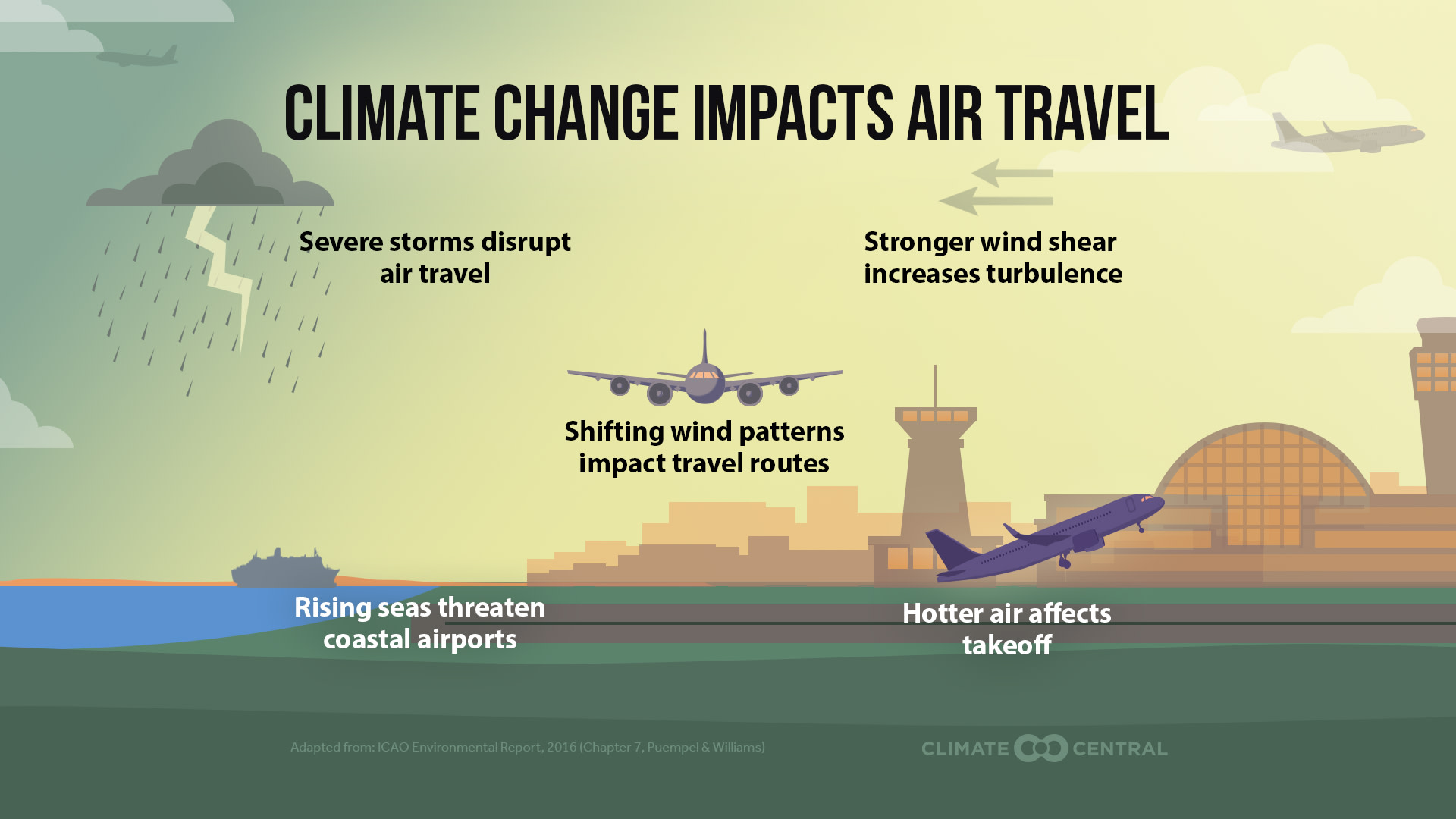
- Burning fossil fuels for aviation contributes to global warming — and the resulting warming is disrupting air travel.
- Flooding caused by rising seas and storm surges threatens access and operations at coastal airports.
- More extreme weather events, warmer air temperatures, and shifts in the jet stream can also disrupt air travel and increase in-flight safety risks.
Last year, 917 million passengers took over 15 million U.S.-based flights — an average of more than 42,000 flights per day.
Fossil fuels burned for global air travel and airport operations contribute to the carbon pollution that is warming the planet. In 2022, global air travel emitted more than 780 Mt CO2, accounting for about 2% of global energy-related CO2 emissions that year. Emissions from aviation have steadily increased, quadrupling from 1966 to 2018.
Air travel not only contributes to heat-trapping pollution — the resulting warming now poses new and growing challenges for air travel.
Weather currently causes more than 75% of air traffic delays in the U.S. As climate change worsens coastal flooding and extreme weather events, more flights could be grounded from weather-related delays. A warming atmosphere can also increase in-flight turbulence.
Click the downloadable graphic: Climate Change is Disrupting Air Travel
Five ways climate change is disrupting air travel
1. Coastal airports are at risk from rising seas and storm surges.
Rising seas due to human-caused warming are worsening coastal floods during both regular high tides and coastal storms; and storm surge is affecting larger areas in many U.S. cities because of rising seas.
Runways at some major airports in U.S. cities and abroad are at risk of closures, delays, and damage due to coastal flooding, particularly after major storms. Access for passengers and employees can also be impacted if access roads are inundated.
2. Heat can affect plane capacity and restrict takeoff.
Warm air is less dense than cool air. Hotter temperatures at ground level therefore make it more difficult for airplanes to gain enough lift to take flight.
Hotter temperatures can cause weight restrictions for flight take-off — meaning fewer passengers and reduced capacity for luggage, cargo, and fuel. In some cases, planes may require longer runway distances to generate enough lift.
3. Climate change is increasing the risk of lightning strikes in flight.
The potential for severe storms is increasing in some parts of the U.S., particularly in the eastern half of the country. One study projects that annual lightning strikes in the U.S. could increase by 12% for every 1°C (1.8°F) of global warming.
Lightning strikes can damage electrical systems and equipment on large commercial aircraft. The average passenger plane is struck by lightning one or two times per year. Following lightning strikes, planes are subject to inspection and repairs, which can take them out of service and cause delays.
4. A shifting jet stream could mean a longer round trip journey.
In recent decades, scientists have observed changes in the jet stream — narrow bands of strong wind high in the atmosphere that move west to east along the boundaries between hot and cold air. The influence of global warming on these observed changes is not yet fully understood.
Research suggests that changing wind patterns could impact travel times in the Northern Hemisphere — potentially making west-bound flights longer, while speeding up east-bound flights. These changes could affect route planning, scheduling, and fuel consumption.
5. Increased wind shear in the jet stream is causing more hazardous turbulence.
One observed change to the jet stream includes stronger wind shear at flight cruising altitudes, which can increase turbulence during flights.
A certain type of turbulence known as clear-air turbulence can’t be seen by pilots or detected by radar. Clear-air turbulence is more likely to occur during winter months.
A recent study found a 41% increase in severe clear-air turbulence over the U.S. between 1979 and 2020 — and it is projected to increase further due to climate change.
The future of flying
Reducing heat-trapping pollution from air travel now is critical to limit future warming. But some consequences from rising temperatures are unavoidable, even with rapid cuts to carbon pollution. The aviation industry is faced with a need to adapt air travel for a warming world to protect passengers and employees, as well as keep costs under control.
Adaptation measures, including seawalls or other coastal defenses, can help protect existing airports from rising seas and storm surges, but they can be costly and complicated. The Shoreline Protection Program at San Francisco Airport is one example of how U.S. airports might build climate resilience.
In especially hot locations or during summer, airports may choose to schedule flights during cooler parts of the day to mitigate heat effects. Where possible, airports may expand runways to accommodate longer takeoff distances.
Local story angles
Find out if your local airport is vulnerable to coastal flooding
Read Climate Central’s assessment of 23 major U.S. cities that are vulnerable to coastal flooding during this decade. Or use Climate Central’s Coastal Risk Screening Tool to map localized vulnerability to sea level rise and storm surges around your city’s airport.
See which airports are experiencing delays
Extreme weather events, heat, or flooding can ground planes and disrupt domestic and international air travel with cascading impacts. The Federal Aviation Administration provides status updates on delays at airports across the U.S. (but specific flight information and delay causes aren’t reported here.)
